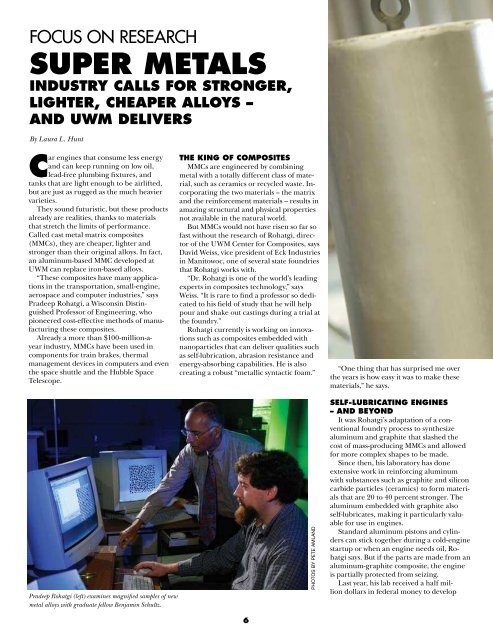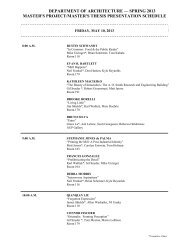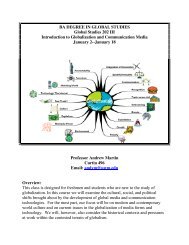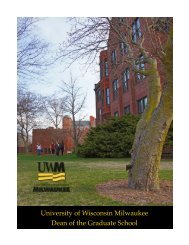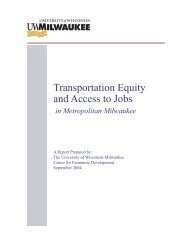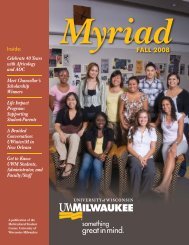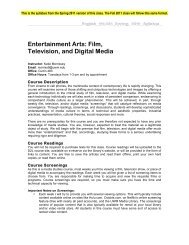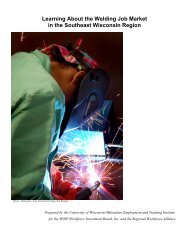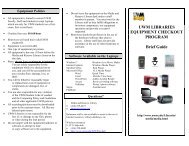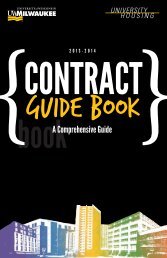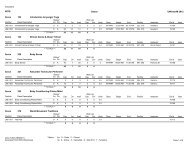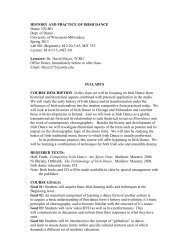ReseARch Muscle - UW-Milwaukee
ReseARch Muscle - UW-Milwaukee
ReseARch Muscle - UW-Milwaukee
Create successful ePaper yourself
Turn your PDF publications into a flip-book with our unique Google optimized e-Paper software.
Focus on ReseaRch<br />
supeR MeTAls<br />
inDusTRY cAlls fOR sTROngeR,<br />
lighTeR, cheApeR AllOYs –<br />
AnD uWM DeliveRs<br />
By Laura L. Hunt<br />
car engines that consume less energy<br />
and can keep running on low oil,<br />
lead-free plumbing fixtures, and<br />
tanks that are light enough to be airlifted,<br />
but are just as rugged as the much heavier<br />
varieties.<br />
They sound futuristic, but these products<br />
already are realities, thanks to materials<br />
that stretch the limits of performance.<br />
Called cast metal matrix composites<br />
(MMCs), they are cheaper, lighter and<br />
stronger than their original alloys. In fact,<br />
an aluminum-based MMC developed at<br />
<strong>UW</strong>M can replace iron-based alloys.<br />
“These composites have many applications<br />
in the transportation, small-engine,<br />
aerospace and computer industries,” says<br />
Pradeep Rohatgi, a Wisconsin Distinguished<br />
Professor of Engineering, who<br />
pioneered cost-effective methods of manufacturing<br />
these composites.<br />
Already a more than $100-million-ayear<br />
industry, MMCs have been used in<br />
components for train brakes, thermal<br />
management devices in computers and even<br />
the space shuttle and the Hubble Space<br />
Telescope.<br />
Pradeep Rohatgi (left) examines magnified samples of new<br />
metal alloys with graduate fellow Benjamin Schultz.<br />
The king Of cOMpOsiTes<br />
MMCs are engineered by combining<br />
metal with a totally different class of material,<br />
such as ceramics or recycled waste. Incorporating<br />
the two materials – the matrix<br />
and the reinforcement materials – results in<br />
amazing structural and physical properties<br />
not available in the natural world.<br />
But MMCs would not have risen so far so<br />
fast without the research of Rohatgi, director<br />
of the <strong>UW</strong>M Center for Composites, says<br />
David Weiss, vice president of Eck Industries<br />
in Manitowoc, one of several state foundries<br />
that Rohatgi works with.<br />
“Dr. Rohatgi is one of the world’s leading<br />
experts in composites technology,” says<br />
Weiss. “It is rare to find a professor so dedicated<br />
to his field of study that he will help<br />
pour and shake out castings during a trial at<br />
the foundry.”<br />
Rohatgi currently is working on innovations<br />
such as composites embedded with<br />
nanoparticles that can deliver qualities such<br />
as self-lubrication, abrasion resistance and<br />
energy-absorbing capabilities. He is also<br />
creating a robust “metallic syntactic foam.”<br />
6<br />
Photos by Pete AmlAnd<br />
“One thing that has surprised me over<br />
the years is how easy it was to make these<br />
materials,” he says.<br />
self-lubRicATing engines<br />
– AnD beYOnD<br />
It was Rohatgi’s adaptation of a conventional<br />
foundry process to synthesize<br />
aluminum and graphite that slashed the<br />
cost of mass-producing MMCs and allowed<br />
for more complex shapes to be made.<br />
Since then, his laboratory has done<br />
extensive work in reinforcing aluminum<br />
with substances such as graphite and silicon<br />
carbide particles (ceramics) to form materials<br />
that are 20 to 40 percent stronger. The<br />
aluminum embedded with graphite also<br />
self-lubricates, making it particularly valuable<br />
for use in engines.<br />
Standard aluminum pistons and cylinders<br />
can stick together during a cold-engine<br />
startup or when an engine needs oil, Rohatgi<br />
says. But if the parts are made from an<br />
aluminum-graphite composite, the engine<br />
is partially protected from seizing.<br />
Last year, his lab received a half million<br />
dollars in federal money to develop<br />
lighter, heavy-duty materials to meet the<br />
U.S. Army’s need for vehicles that can be<br />
airlifted and operate for prolonged periods<br />
without refueling.<br />
For all the work he has done with major<br />
car companies and Wisconsin partners<br />
like Oshkosh Truck Corp., Rohatgi says<br />
the largest users of MMCs have not been<br />
in transportation, but in the computer<br />
industry.<br />
Computer applications require smaller<br />
volumes of MMCs, and they often have<br />
the money to invest in new technologies,<br />
he says. “You look for the big bang in one<br />
area, and it happens in another.”<br />
nAnOsTRucTuReD AluMninuM<br />
AnD MeTAl fOAM<br />
The newest class of MMCs that his lab<br />
is developing fortifies aluminum with<br />
nanoparticles to produce materials that<br />
can withstand enormous amounts of stress<br />
and are exceptionally hard, but also are<br />
lightweight. Nanoparticles are smaller than<br />
100 nanometers (about the size of a baseball<br />
shrunk to one-millionth of its original<br />
size) that sometimes behave differently<br />
than larger particles.<br />
A nanostructured aluminum can be 10<br />
times stronger than conventional aluminum<br />
alloys.<br />
A third kind of MMC Rohatgi is working<br />
on turns metals into foam.<br />
Unlike Styrofoam, which contains<br />
air bubbles in a plastic matrix, syntactic<br />
(metallic) foam is filled with hollow microballoons<br />
set into a metal base. The tiny<br />
balloons are made from recycled fly ash<br />
– waste material generated by coal-burning<br />
power plants. They may be filled with various<br />
gases, or house a vacuum.<br />
“The cells are smaller and more regular<br />
than air bubbles, which make them better<br />
at energy absorption, in the case of a car<br />
crash, and also useful at sound dampening,”<br />
he says. “They are also very light,<br />
and there may be an interest in aluminum<br />
foam in homeland security issues. It can<br />
make buildings, including bomb shelters,<br />
more blast-proof and fire-resistant.”<br />
The fuTuRe Of fOunDRies<br />
Now in his 21st year at <strong>UW</strong>M, Rohatgi<br />
continues to help foundries, such as Eck<br />
Industries, diversify their businesses with<br />
MMC casting, giving them a defense<br />
7<br />
Pradeep Rohatgi, Wisconsin Distinguished<br />
Professor of Engineering, inside the Foundry<br />
and Solidification Laboratory at <strong>UW</strong>M.<br />
against competition from other countries<br />
where labor is cheaper.<br />
His lab is researching techniques that<br />
will enable industries to manufacture composite<br />
components with increased speed<br />
– and the new technology will take the<br />
process out of the factory, making on-site<br />
manufacture of parts possible.<br />
The U.S. military also is interested in<br />
developing the capability of quickly producing<br />
replacement parts for vehicles while<br />
on the battlefield. Rapid manufacturing<br />
technologies can be expanded to include<br />
lightweight materials for bone replacement<br />
implants and tissue scaffolds, says Rohatgi,<br />
improving the treatment of wounded soldiers<br />
in mobile environments.<br />
“The only way to keep foundries viable<br />
is to help them develop fast-track technologies<br />
to manufacture components from<br />
advanced lightweight materials,” he says. “It<br />
gives old-line manufacturing the means to<br />
produce high-tech products.”


